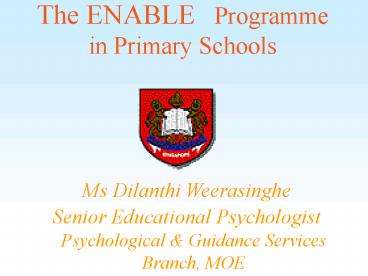The ENABLE Programme in Primary Schools - PowerPoint PPT Presentation
1 / 27
Title:
The ENABLE Programme in Primary Schools
Description:
Senior Educational Psychologist Psychological & Guidance Services Branch, MOE ... Additional Resources & teaching packages for EL and Maths. ... – PowerPoint PPT presentation
Number of Views:59
Avg rating:3.0/5.0
Title: The ENABLE Programme in Primary Schools
1
The ENABLE Programmein Primary Schools
Ms Dilanthi Weerasinghe Senior Educational
Psychologist Psychological Guidance Services
Branch, MOE
2
Objectives
- To introduce students on the NED 115 Module to
the ENABLE Programme. - Context
- Causes Characteristics of Underachievers
- Identification of Underachievers by PGSB
- PGSB support to schools in the ENABLE Programme
3
sychological uidance ervices ranch
P G S B
4
Mission Statement
- To provide a comprehensive psychological and
guidance service to schools to enable them to
maximise the potential of every child in the
areas of cognitive, affective, character and
career development.
5
Anchor Programmes
- LSP (EL and Math)
- ENABLE
- Lifeskills Programme
- Education and Career Planning Programme
- Conflict Manager (Peer Mediation) Programme
6
The ENABLE Programme
couraging chievement and etter earning
EN A B LE
7
ENABLE Programme
- formerly known as the Underachievers Programme
(UAP) - is a programme for the underachievers, i.e.
pupils of at least average ability but are
under-performing in school - supports uas in English and/or Maths from P1-P3
- speciliased remediation techniques(EL/ M)
- small group support (n10-12), normally outside
of curriculum time - involves several teachers in the school,
coordinated by the schools ENC
8
THE ENABLE PROGRAMME
Identification of UA pupils
Parental consent
Assessment of pupils strengths weaknesses
Profile of pupils identification of needs
Planning implementing focused diagnostic
teaching
Monitoring evaluation
Good progress - pupil discharged Some progress
made but inadequate progress gt pupil remain No
improvement significant difficulties in
learning behaviour gt refer pupil to PGSB
9
Some typical characteristics of underachieving
pupils
- Procrastination
- Daydreamers
- Poor self image
- Lack application
- etc
10
Reasons for underachievement?
- Language problems (EAL)
- Attitude problems - lacking in motivation, poor
self-discipline, low self-esteem, boredom, lack
of interest, Weak attention and concentration
skills, boredom - Poor organisational skills and study habits
- Learning disabilities e.g dyslexia
- Weak grasp of skills taught
11
Possible Home Factors
- Parents - control vs over dependent
- Sibling factors sibling with a disability.
- Marital problems
- Power struggle between parents/ parents vs
grandparents. - Parents skills
12
Identification of ua pupils
- Identification is a process
- Use the 5 dimensions of learning as a framework
- Use various sources of data and information for
evidence of underachievement - Do NOT just depend on marks alone
13
5 Dimensions of Learning (Barrs et al)
- A theoretical framework that highlights 5
dimensions which underlie successful learning
for pupils. - Can be used as a framework
- to understand childrens learning and
underachievement - for identifying underachievers
- for measuring/observing a learners progress
(positive change)
14
Who are the Underachievers ?
Five Dimensions of Learning
Knowledge Skills Strategies Rate of
Learning Experiences Confidence
Independence Reflectiveness
The 5 dimensions interact influence a childs
learning
15
Five Dimensions of Learning
Knowledge Skills
Understanding assessing a childs knowledge
skills goes beyond merely looking at exam results.
16
Five Dimensions of Learning
Strategies
Strategies can be helpful constructive, but it
can also be inhibiting unhelpful (e.g.. when a
child is fixed on a particular approach thus
unable to unlearn)
17
Five Dimensions of Learning
Experiences
Children vary in the range variety of
experiences that they will bring to a learning
situation which will affect the achievement they
demonstrate.
18
Five Dimensions of Learning
Confidence Independence
Confidence Independence reflect the childs
pleasure involvement in a learning activity
view of himself as a learner.
19
Five Dimensions of Learning
Reflectiveness
1. Childs ability to self-evaluate 2. Ability to
establish meaningful links between one learning
situation to another 3. Ability to generalise
apply learning experiences
20
Who are the Underachievers ?
Teachers Tasks in identifying an underachiever -
how is it done ?
- Training - teachers received specialised training
from PGSB to assist them in the identification
and support of the UAs - Framework guidelines provided to schools
- Support from PGSB to schools and ENABLE trained
teachers
21
Training to teachers in the ENABLE Programme
- Initial specialised training from PGSB to assist
qualified teachers in the identification of the
UAs - 24 hours of Specialised Training (Jan - April)
- Emphasis of training on Identification,
Assessment, Diagnostic Remediation, Managing a
range of pupils needs Motivation. - Certificated from MOE
- Ongoing training support to ENCs - Zonals,
regular school visits by PGSB officers - Specialist Resources Teaching materials for
ENABLE Pupils.
22
Support for Pupils in the ENABLE Programme
23
Support within school
- ENCs role
- to monitor oversee the ENABLE Prog
- to share skills and knowledge
- to help identify the uas
- to mentor new ENABLE teachers
- to build up resources
- to liaise with PGSB officers
- to liaise with external agencies
24
Service Delivery via MST
- Primary schools obtain PGSB services through the
multi-skilled teams. - A Multi-Skilled Team consists of
- Educational Psychologists (EP)
- Guidance Specialists (GS/GO, GS/EC)
- Reading Specialists (RS)
- Educational Psychology Assistants (EPA)
25
PGSB SERVICES OFFERED TO SCHOOLS IN THE ENABLE
PROGRAMME
- Specialised Training
- - Initial 24 hr. training for teachers
- - Initial ongoing training for ENCs
- - Opportunities for ENCs to network share good
practice - Additional Resources teaching packages for EL
and Maths. - School/ Cluster based workshops for teachers and
parents of pupils in the Programme.
26
PGSB SERVICES OFFERED TO ua PUPILS
- Psychological and literacy assessments
- Assessments for referral to other agencies
- e.g. DAS, ARC, hospitals
- Development of individual education programmes
for learning and behaviour - Counselling children with behaviour problems
- Study and social skills training
27
Q A































